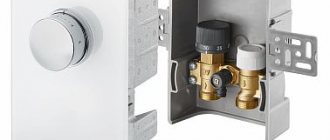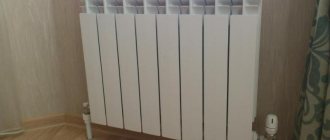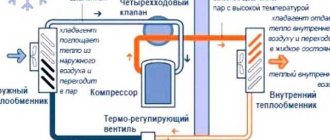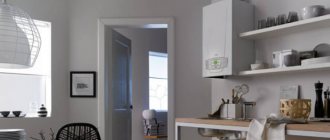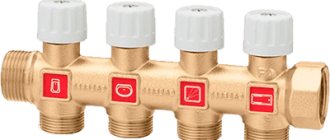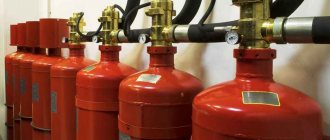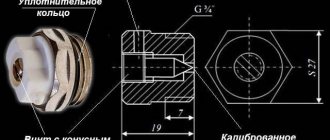A radiator heating system and heated floors are not the only way to heat a room. Recently, warm baseboards have become increasingly popular. This type of heating appeared on our market only a few years ago and there is not much experience in its operation yet. However, it is quickly gaining popularity - it is the most discreet and very comfortable type of heating.
Warm baseboard - small heaters located along the floor around the perimeter of the room. They are named so because of their location and size: the thickness of such a heater is 2.5-3 cm, which is comparable to the size of a standard floor plinth. The height is larger: 12-15 cm, but everything looks organic. What is important: such a system does not limit the installation location of furniture and decorative items, since heat is transferred not by convection, but by radiation.
This is what baseboard heating looks like. No more other heating devices
Operating principle and differences
Manufacturers of baseboard heating claim that the system is more economical than all other types of heating. Savings are 20-30%. This happens because lower temperatures are required to achieve a comfortable feeling. This is because most of the heat is transferred by radiation rather than by convection.
Almost all existing heating systems do not create the best thermal picture: warm air accumulates at the top, while cold air remains at the bottom. If the room does not have very high ceilings, the situation is tolerable, but in rooms with large heights this is critical. To equalize the temperature picture, forced convection is used: fans are built into heating devices that more or less effectively mix the air masses. But active air movement carries dust and germs. At the same time, stagnant zones still remain in the corners of the rooms, in which cold air accumulates.
When using baseboard heating there is no thermal cushion at the top, the air is fresh and the feeling is comfortable
Uneven temperatures and dust in the air are not all the troubles of convection heating. There is also dampness that appears on the walls. The fact is that convection heats the air. The walls remain cold. When warm air comes into contact with cold walls, condensation occurs, the walls become wet, and fungi and mold develop. Moreover, this picture is typical for houses and apartments with good insulation.
Baseboard heating works differently. The first important difference: the lower layers of air immediately heat up, which is already comfortable. Gradually and slowly rising up along the walls, the air cools, transferring heat to the walls. Therefore, it turns out that the top is not warmer (or not much warmer) than the bottom.
Only about 20-30% of the heat is spent on heating the air by convection. Everything else goes to heating the walls. And this is the second important difference. The heated air rises along the walls, rather than mixing with the rest (this effect was noticed by the scientist Coand). Therefore, the rising warm flow cuts off the cold from the walls and heats them. Yes, while the walls heat up and dry out, a lot of energy (and fuel) is consumed. But after that the entire surface begins to radiate heat.
This is where the savings zone begins: a person feels comfortable if the wall temperature is 36-37oC and the air temperature is 16oC. We simply feel the heat emanating from the walls with the entire surface of the body. At the same time, the cost of maintaining the temperature of dry walls is low. After all, it is the water contained in the materials that is the best conductor of heat, and the air that replaces it, on the contrary, conducts heat poorly.
This is what one of the options looks like up close
That is why with such heating it is not so important whether there are pieces of furniture along the walls or not: it is mainly the walls that are heated, not the air. Let them take away some of the heat, but then they themselves will begin to give it back. But the walls will heat up anyway.
Can a warm baseboard become full-fledged heating?
Manufacturers claim that such heating can completely replace radiators. However, in practice we encounter the opposite.
- In order for a baseboard heating system to fully warm a room, careful engineering calculations are required, taking into account the size of the room, the average temperature inside and outside the room, the thickness of the walls, etc.;
- In conditions of severe winters and frosts, such heating is simply not able to cope with its functions and requires additional heating, wall insulation and other measures to create heat in the room;
- The modules are installed close to the wall and contribute to its heating, which limits the choice of wall covering finishes;
- Heating circuits of water systems are limited in length. In large rooms this requires additional installation of autonomous circuits and their separate output;
- This type of heating is highly expensive, which makes it inferior to classic radiators;
- Difficulties of installation in an apartment building. When installing a water type, you will have to take a special permit;
- Electric skirting boards significantly increase the amount of monthly utility bills for electricity.
Thus, baseboard heating is undeniably convenient and aesthetically pleasing, and also performs its functions of heating the room. However, in Russian winter conditions this type of heating is more suitable for heating public premises, country houses, small premises, as well as regions with high average annual temperatures. Despite manufacturers' statements, a warm baseboard, for a number of compelling reasons, cannot fully replace conventional heating radiators.
Types of heating baseboards
Structurally, the baseboard heating system consists of a heating module covered with a decorative aluminum strip. The heating module consists of two copper tubes on which aluminum plates are mounted. Copper is known to have high heat transfer and high resistance to corrosion, but has a high price. Aluminum also transfers heat well and is much cheaper. This copper + aluminum combination is used in many heating devices and has proven its effectiveness.
Read about copper and copper-aluminum radiators here.
This is a baseboard heating design
There are two ways to heat the heat transfer module: using a coolant (water or antifreeze) and an electric heating element. On this basis they differ.
Electric heating
Special low-temperature heating elements are inserted into electric baseboards. They heat up to a maximum of 60 oC. At the same time, their power is more than enough: one linear meter produces about 180-280 W. Electric heaters are inserted into the lower tube, and a cable in a special sheath is laid into the upper tube. With its help, voltage is supplied to all sections of the heating element. The length of one is from 70 cm to 2.5 m, and from different lengths of heaters the power necessary to heat the room is collected.
A special heating element is inserted inside the copper tube. This is how you get an electric warm baseboard
Water warm baseboard
When using water or antifreeze to transfer heat, the same modules are connected into a single heating circuit. There is only one limitation: for maximum heating efficiency, the length of one circuit should not be more than 12.5-15 m (different lengths for different manufacturers).
If there are several circuits for installing a warm water baseboard system, it is convenient to connect a collector (comb). You can use the most common model or with flow meters - it’s your choice. Heating modules for the water heating method are selected based on the required power for a specific thermal pressure of the system.
Combs for warm baseboards are similar to combs for heated floors. Read about them here.
Calculation of the length of the heating element
The thermal pressure of the system ΔT is the difference between the temperature of the heating device and the air (tb). The temperature of the heating device is calculated as the arithmetic mean between the temperatures of the supply (tp) and return (to) pipelines.
ΔT = ( t p + t o)/2 - t in
Let's calculate the pressure for a system with a supply of 90 oC, a return of 70 oC, and the air should be 20 oC. It turns out ΔT = (90 + 70)/2 - 20 = 60 oC. This mode is called high temperature.
Baseboard heating does not work with these parameters. Typically, the difference between the supply and return temperatures is no more than 5 oC. Optimal mode: supply 60 oC, return 55oC. When maintaining +20 oC in the room, the thermal pressure of the system will be ΔT = (60+55)/2 - 20 = 37.5 oC.
If the parameters of your system are similar, determine the required length of the heating module in the column with this thermal pressure. If the parameters are different, find the value for your temperatures.
Below is a table of the thermal power of Mr.Tektum baseboard heating. The designations are slightly different, but the principle is the same. Find the required value of thermal pressure, and, in the corresponding column, find the power per linear meter for your system. Knowing the heat loss of the room (read how to calculate it here), you can determine how many meters of heating element you will need.
Table of dependence of the power of a warm baseboard on the temperature delta (thermal pressure)
For example, at ΔT = 37.5 oC to compensate for room heat loss of 1500 W, the thermal power (according to this table) is 162 W. This means that you will need 1500/162 = 9.25 m of heating element.
What and how to connect
Having gained the required length in total, distribute it around the perimeter of the room, combining it into closed contours. Heater sections are connected to each other in several ways:
- flexible stainless steel pipes with union nuts or under a press;
- copper pipes and fittings for soldering;
- copper or brass threaded fittings.
The most reliable connection method is copper pipes for soldering. This option is also suitable for central heating systems, since such connections can withstand up to 30 bar. The most difficult thing to do is assemble with threaded fittings: the dimensions and distances between the tubes and from the wall are small, making it very inconvenient to work. Flexible pipes must be chosen that are reliable: heating and hot water require good quality.
Connect the heating elements of heating baseboards using hoses and copper pipes
The line from the boiler or floor comb must be made of materials compatible with copper: polymer (polyethylene and reinforced polypropylene), metal-plastic or copper pipes.
System Features
The system is compatible with boilers of any type using any fuel. But there is one feature: for normal heat transfer, a high speed of coolant movement is required. With natural it will simply be ineffective. Therefore, it is important to choose the right pump.
Installation of warm baseboard
For installation you will need tools: adjustable wrenches in a set, a drill with an impact function (or a hammer drill), a hammer, wire cutters, pliers, scissors (to cut plastic). A baseboard heating system can be quickly installed if the connection points are prepared in advance.
Even before purchasing the necessary equipment, you need to plan what power the heating elements need and how to place them around the perimeter of the room.
Assembling a water heating system
Stage 1. We measure the distance from the point where the distribution manifold will be located to the location of the baseboard. We cut two lengths of the protective pipe and two with an allowance of 20 cm for the connecting pipe. We insert the connector into the protective one, and seal the ends with adhesive tape to protect it from dirt.
Stage 2. We pull the pipes along the floor without tension so that if extensions are necessary, one or more can be laid nearby. We fix it with mounting tapes, cover it with a protective solution, protecting it from damage, and place it in the right place on the wall 6 cm above the floor and 10-15 cm from the edge of the wall or corner, fix it with cement.
Stage 3. After laying the finished floor, we continue work. We glue an insulating strip along the entire length. We stretch the aluminum edge (also along the entire length of the heating), covering the junction of the wall and the floor. Screw it or secure it with adhesive tape or silicone.
Stage 4. We lay a special profile along the top line, put holders on it at a distance of 15 cm from the corners and every 40 cm along the wall.
Stage 5. To connect heating pipes and heating elements, we use couplings with nuts, bushings and gaskets, in the corners - 90º corner rotary tubes, in the ends - 180º end rotary tubes and plugs. We connect the thermal sections with adapters.
When connecting the heating module, you need to remove 2-3 lamellas from the edge and put connecting nuts, crimping parts, and rubber gaskets on the tubes
Stage 6
We carefully press the connected heating sections into the holders. We put on decorative panels (attach with screws or snap on) and decorative corner elements. We connect the system to the manifold, fill with water, test at operating and maximum pressure
Like all collector systems, the heating baseboard requires a circulation pump to stimulate the movement of the coolant. Without a pump, it is difficult for heated water to circulate along an extended circuit. However, the use of technical devices affects the overall cost of the system.
The plinth will work if all technological operations were performed without violations. If there is a leak, the problematic connections must be tightened with a wrench. The coolant is supplied through the collector by a circulation pump from the boiler or from a general (centralized) heating system.
Electric heating system assembly
For a warm baseboard, a separate circuit breaker must be made in the electrical panel. Its power is determined by the number of heating modules.
Stage 1. We supply power to the distribution box, which should be near the location of the system at a height of 4-6 cm from the floor.
Installation of an electric heating system: most often, the electric system is used where it is possible to supply the required power, or in small rooms as additional heating
Stage 2. Apply insulating tape to the wall.
Stage 3. We install the lower aluminum profile (edge) and the upper one, onto which we attach holders at the same distance as for the water system - 15 cm from the corners and in increments of 40 cm along the wall. We install a remote thermostat. It should be located at a height of about 1.5 m opposite the system modules and at a distance of at least 2 meters from them.
Stage 4. We insert electric heating elements (heating elements) into the lower pipe of the heating module, fix the modules in the holders so that they do not touch the wall.
The electrical contacts of the heating elements have a thread, two nuts, a retaining ring on a spring, and a heat-shrinkable tube for additional insulation. The modules are connected in parallel using a heat-resistant power cable coated with silicone and heat-resistant up to 180°C.
Stage 5. We close the system with a plastic box from above.
To connect heating modules, a 3-core cable is used: brown wire - phase, blue - zero, green (yellow) - ground. The cable must be grounded
It is best to entrust the connection of the installed heating system to the power supply to an electrical specialist. He will check the reliability of the insulation with measuring instruments, supply electricity and adjust the thermostats.
Scope of application, prices, manufacturers
You can install a baseboard heater in any room for any purpose. There are special models for high humidity conditions. From a design point of view, they are almost ideal: they do not spoil the interior and do not attract attention. It feels very comfortable to be in such a room: the air is fresh and there are no foreign odors.
There is only one feature: they are effective in homes with permanent residence. At a minimum, with constant heating at low temperatures and periodic increase to a comfortable level. The fast heating mode is not their area of application: the power is low. Requires long heating time.
There are both European and domestic manufacturers on the market. With prices and quality as usual: Europeans have beautiful, reliable, expensive; Domestic ones are cheaper, but worse made. And the difference is not only in appearance. This is often more or less normal. The problem is the occurrence of creaks and clicks in the system during sudden heating and cooling. This problem is typical for the connection of two metals: different temperature expansion provokes the occurrence of this effect. Europeans have been producing such equipment for decades and have learned to deal with it. Ours don’t know how yet. So this is the feature. Based on this, whenever possible, install warm baseboards from trusted and venerable manufacturers in your bedrooms.
There are models with copper plates. They have very high heat transfer and corresponding prices
By names and countries of manufacturers something like this:
- Chemo Thermboard - Austria
- Best Board Austria
- Termaskert - England
- Thermia - Ukraine
- Aurora - Ukraine
- Mr. Tectum - Russia
- KZTO - Russia
Advantages and disadvantages
The advantages are as follows:
- Uniform heating of the room without cold and warm zones.
- Oxygen is not burned.
- Reducing the cost of maintaining a comfortable temperature by lowering it by several degrees
- Heating occurs by thermal radiation from warm walls.
- Ease of integration into any interior.
- Easier installation (compared to heated floors).
If you do not take into account the statement “they will not heat anything,” one drawback has so far been identified: the high price. There is another one, but indirect: a warm water baseboard - a multi-component system. It’s not easy to design and connect everything correctly. Electric skirting boards are a little easier, but require skills in working with electricity. That is, in both cases, installation by professionals is desirable, or detailed clarification of details and features from dealers or manufacturers.
The principle of operation of baseboard heating in a graphical representation: at head level (approximately 1.6-1.7 meters) the temperature reaches a comfortable 18-20 oC
Objectively about all the advantages and disadvantages
The ascending heat flow, according to Coanda's physical law, is pressed against the wall. Without mixing with the rest of the air in the room, it heats the vertical surface. At a height of up to one and a half meters, the wall temperature is several degrees higher than in the room, and this creates thermal comfort for the people in it.
During the heating season, the heating system is used for 6-8 hours every day. By multiplying the total power by the number of hours worked per month, we get the monthly energy consumption indicator.
The distribution manifold evenly distributes the coolant among the individual circuits. Its choice is determined by a number of factors - product material, comb throughput, pressure, energy consumption, possibility of further expansion
Do baseboard heaters really save energy resources due to the low temperature of the coolant?
The answer would be this example:
- Room area - 3.5m x 5m (17.5 sq. meters), perimeter - 17 m (minus the doorway - 16 m).
- Room volume with a ceiling height of 2.7 m: 17.5 * 2.7 = 47.25 cubic meters. meters
- The outside temperature in winter is on average -10 ºC.
- To maintain +20-22ºC in a room with normal thermal insulation, 1.5 kW/hour is required. The heating will operate 7 hours a day.
Taking into account 200 W per 1 meter of length when heating the coolant to 65 ºС (see above), we get 200 W * 16 m = 3200 W or 3.2 kW. Since this flow rate is twice as high (3.2 kW/1.5 kW = 2.1), it is possible to reduce the coolant temperature in the same proportion: 65 ºС / 2.1 = 31 ºС.
Let's calculate the monthly electricity consumption: 1.5 kW/hour * 7 hours. * 30 days = 315 kW. More reliable results are obtained by detailed thermal engineering calculations based on complete initial data on the object.
If we compare the efficiency of heated floors and baseboards, then we can argue, if only for the reason that convectors from the floor immediately heat the air, and part of the warm air from the baseboard is taken over by the outer wall, which is constantly fed by the cold outside.
The heat spent on constant heating of cold external walls is a kind of loss. Is their dryness, lack of mold, and dampness a compensation for this? There is also debate on this issue: some say yes, others point out that the humidity in the room is regulated by supply and exhaust ventilation, and not by heating.
If water radiators are connected in series, the coolant will cool while it goes around the entire perimeter. Therefore, the modules are combined in parallel, each pair of incoming and outgoing pipes is output to the collector separately
As for the appearance, the baseboard boxes that cover the heating really look beautiful in the interior, but when there is cabinet furniture in the room, problems arise - it is not possible to go around it in front, and behind it the warm air does not have freedom of movement.
And regarding the absolute absence of dust in the air, it is worth objecting - perhaps there is less of it than with air circulation in traditional heating systems, but it is there, since convection is present.
In general, we can conclude that baseboard heating radiators already have buyers, and over time their number will increase. The limiting factor is the excessively high cost of equipment, which is explained by the use of copper, brass, aluminum in production, i.e. expensive materials.
And installation, if you order it from professionals, is not cheap. Skirting pipe routing is the most complex of all available water heating circuits, but there are also many nuances in the assembly of electric baseboards.
How to make a warm baseboard with your own hands
Even if made in Russia, this pleasure is not cheap. But what if you want to try such a system, but don’t have a lot of “extra” money? Do it yourself. There are two working options.
Option one
Unannealed copper pipes with a diameter of 12 mm and roofing copper sheets 0.4 mm thick were used. The order of work is as follows:
- Cut a strip of roofing copper (60 cm) with a grinder into strips of 15 cm.
- The edges of the full length strips should be beaded at an angle of 90o and the flange length is 7-8 mm. The length of the strips is no more than 3 meters - it is inconvenient to work with large pieces.
- Solder copper tubes to the back side of this plinth. To do this you need solder (plumbing solder containing 3% copper) and a torch. When soldering, point the torch at the tube: the strip is thin and will warp if overheated. The tube can withstand heat normally.
- Bend the ends of the tube slightly before soldering. This will make it more convenient to put adapters on them.
- For assembly, oil and petrol resistant hoses were used that can withstand working with coolant up to 120 oC (internal diameter 12 mm). At the connection points with the pipe they were secured with ordinary clamps.
- To regulate the temperature, a manually adjustable thermostat is installed.
- The joints are covered with similar inserts/plinths made of copper, but without pipes.
- The panels are attached directly to the wall using standard mounting clips (by the pipes). Do not insert them into the recesses - most of the heat is lost.
This system has worked in a wooden house for 9 years. There were no problems or need for repairs. The coolant temperature at the inlet is from 50 oC to 70 oC. In a room, 20-21 oC when rising is too hot.
Watch the video about the features of installing warm baseboards. May be useful.
Second option
In this case, aluminum profiles for working with drywall were used to make a warm baseboard with your own hands. Holes are cut (sawed) in them with a grinder at the top and bottom, after which they are attached to the walls. Two copper pipes are laid on a thin aluminum ceiling profile, screwed with aluminum wire. This entire structure is laid inside and fixed to the wall so that the pipes are one above the other. The pieces of such a homemade plinth were assembled by welding with copper pipes and fittings. “Front panel” is the same profile, only painted with radiator paint to match the walls (floor). This homemade warm baseboard is less effective and more difficult to clean, but it is also very functional.
How does baseboard heating work?
To create a system of warm baseboards, heating devices similar to low, long radiators are installed around the perimeter of the room at floor level. They are covered with decorative panels resembling a plinth. Thus, the heating system is hidden from view and does not interfere with the aesthetics of the room.
This heating method was used back in the last century: in old buildings you can find heating devices of this type. However, at that time the option was not widely used due to its high cost.
Now, installing such a heating system will also require more costs than installing conventional radiators, but it is simpler and cheaper than installing a heated floor, and in some cases, more profitable.
The heating device is based on two copper tubes mounted at a distance of up to 15 cm, one above the other. For better heat transfer, they are equipped with perpendicular metal plates, which can be made of aluminum, brass or copper. The structure is covered with an aluminum casing with upper and lower openings for better air exchange.
This design turns out to be extremely effective. Cold air coming from below heats up:
- from pipes and cross plates;
- metal body structure;
- heated walls.
This allows you to quickly and evenly heat the entire volume of the room from floor to ceiling.
Reviews
“I have a baseboard like this at home. In addition to heated floors. I advise you to install it too. The warm baseboard does its job well. Of course, it cannot be compared with warm floors in terms of power, but still there is noticeable warmth from it.”
Nikolay, Moscow
“I installed heated floors and baseboards. I’ll say unequivocally: the price of the baseboard is cheaper, but I like it better for heating.”
Alexander, St. Petersburg
“I bought a Megador 600 W for a 9 m2 bedroom. At first it worked at full power, but now we set it to maintain 20 degrees at 200 W. This is enough for my area, we don’t need a higher temperature, we don’t like it. And at the same time, on the wall where the heater is located, our ventilation hole is almost always slightly open. I'm happy."
Pavel, Chekhov
As you can see, reviews about warm baseboards are positive. This is no wonder: the heating is efficient, comfortable, and even invisible. The only thing that spoils the picture is the high price, but there are options for making it yourself.
Results
Like everything new, the plinth system has many critics and theorists. Their main thesis: “It’s stupid to heat walls and then heat the air. It’s better to heat the air directly, and then start heating the walls.” The point of view is clear. This is what is used for convector heating. But the result and its shortcomings are known to everyone. And for the efficiency of heating the walls, an experiment was carried out: in one room the air was +12 oC, and the walls were heated to +37 oC. And people sweated in it. In another, the air was heated to +40 oC, and the walls were cooled to +12 oC, and people were freezing.





